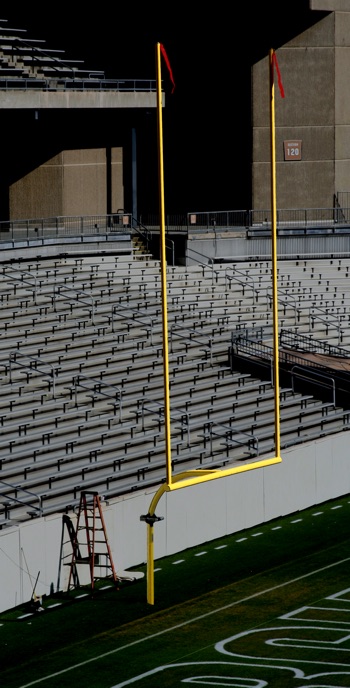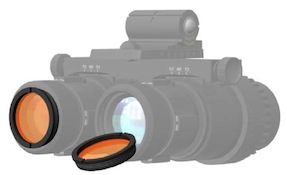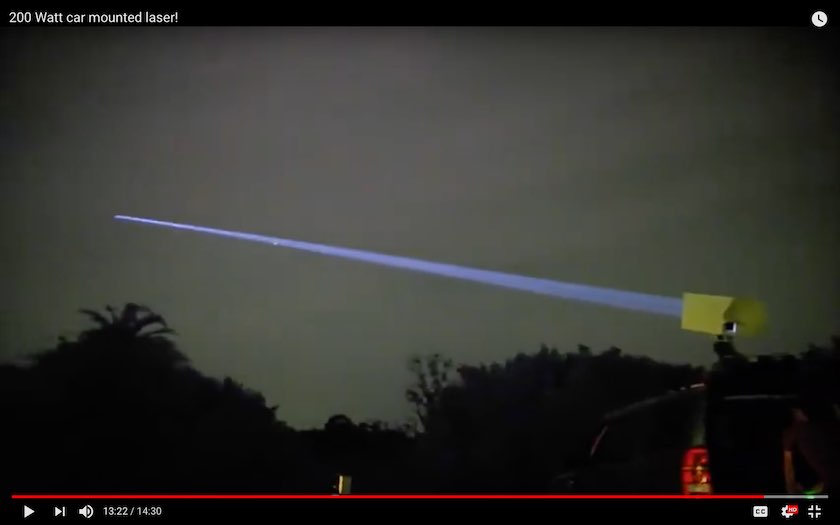Home
A comprehensive resource for safe and responsible laser use
US: YouTuber makes 200 watt car-mounted laser, aims into sky
The video was done by 29-year-old Sarasota, Florida resident Kevin Kohler, who uploads as TheBackyardScientist on YouTube (4,500,000 subscribers) and who is on Twitter as @ChemicalKevy.
In the video, he states "As normal, you should never shine a laser into the sky. But we've checked the flight radar and there's no airplanes in 100 miles that direction."
(Click the link for more additional safety information)
US: Football coach, kicker propose laser goalposts for improved officiating

Goal post at Georgia Tech stadium. Photo by Hector Alejandro from Flickr CC by 2.0. Background darkened to emphasize the subject.
In a February 2015 interview with Sports Illustrated, Florida State University kicker Roberto Aguayo discussed the idea, first brought up by FSU head coach Jimbo Fisher (70 wins, 14 losses, 6 bowl appearances).
SI interviewer Martin Rickman asked “Jimbo mentioned his ideas about putting laser beams on top of field goal posts a while ago, and Georgia kicker Marshall Morgan brought up the notion again last season. Do you feel like electronic accuracy monitoring is something that should be implemented in kicking?”
Aguayo replied:
“Personally, I think the laser idea is a good idea. I’m still behind Jimbo. I’ll back him up on that. Games can be won or lost on a kick. I’ve seen it, a kick has gone close and one ref looks at the other. Not a lot of people know this, but my redshirt year, Dustin [Hopkins] was still kicking, and he hit a 27-yarder. He comes off the field and says, ‘Guys, I missed that.’ But the refs counted it in. They said it was good. It went right over the upright.”
“One of the kicks I missed this year went over the uprights, too. It looked like I missed it, but when they showed it on the JumboTron [TV scoreboard] the whole stadium booed. It looked good on the JumboTron. Depending on what angle you’re looking at, it’s hard. Lasers I feel like would be a good idea. It’s just about figuring out whether if it goes inside the laser it’s good, or if it touches the laser it’s no good. That would have to be discussed. Either get lasers or make the uprights a little bit longer. Kickers are getting much better and they’re hitting it a lot higher.”
From Sports Illustrated
US: 129 laser/aircraft incidents in Florida thus far in 2014
The NBC Miami “Team 6 Investigators” did a report on laser incidents, how pilots are endangered, and the enforcement effort to find perpetrators. The report aired May 16 2014.
From NBCMiami.com
US: Gold-coated nanotech could "laser-proof" pilots' glasses
According to a professor at Embry-Riddle Aeronautical University, gold-tinted eyewear has been used by military pilots for laser protection but only works against certain wavelengths of laser light. However, said Dan Macchiarella, if Thomas’ idea “could be applied to lasers of all strengths and wavelengths, that would certainly be a big advancement.”
A March 10 2013 Orlando Sentinel story noted that funding cuts and competition for grants mean that Thomas’ research faces “some serious hurdles” to develop this idea further. Thomas said finding research money is “going to be very difficult, very difficult.”
From the Orlando Sentinel
US: Tampa police purchase anti-laser filters for night vision goggles
A person wearing NVGs is normally not at risk of retinal injuries, since direct laser light falls on the image intensifier device and not the eyes. (Depending on the NVG mounting style, it may be possible for direct laser light to enter from the side or from parts of the vision not covered by the NVG optics.) However, a serious concern is with laser light causing “blooming” of the night vision enhanced image, or even damaging the NVG sensor. To help prevent this, Night Flight Concepts developed “Laser Armor” Light Interference Filters.

Company consultant Dr. Dudley Crosson says the screw-in filters “allow the goggles to function normally by reducing the blooming effect significantly.” A Laser Armor product sheet says the filters reduce blue (445-450 nm) intensity by 97%, and reduce green (532 nm) intensity by 99.5%.
From Aviation Today and a Night Flight Concepts press release
US: Orlando Sentinel runs article on laser hazards
From the Orlando Sentinel
